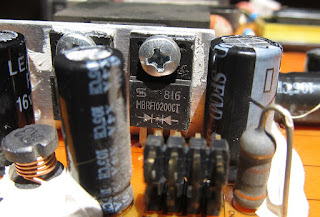Cheap (~$12, less if shipped directly from China) USB sound card with SPDIF input and output (my main reason to buy it).
Irregular PCB shape - I'm guessing 2 PCB pieces are made from one panel, this would save about 5 cm^2 of the PCB. Producent margin and labor cost must be pretty low if this is economically viable.
https://tehnoblog.org/c-media-cm6206-5-1-usb-audio-sound-card-line-in-line-out-bass-extension-low-frequency-response-upgrade/ has quite detailed description of similar sound card. While mine has slightly different PCB (SMD capacitors, slightly smaller, not rectangular, no headphone output pins on the PCB, no pads for EEPROM) it also had incorrect polarization of electrolytic capacitors at the outputs:
While this kind of software should be simple to use, it is quite unintuitive. I found few comments that SPDIF output is not working on this card and I'm not surprised, it took me maybe 30 minutes to figure it out. While this sound card could have up to three outputs (line out, headphones - not available on this PCB - and SPDIF) they cannot be switched using Windows mixer as it would always show two inactive outputs as "disconnected" (even though detecting disconnected SPDIF output would cost more than this whole card). Only one output can be active at the time, so you can't have Line Out and SPDIF playing same time. In "Xear" CMedia software two out of three outputs would be grayed. You cannot just click on Speaker/Headphone/SPDIF output icon to switch to this (even if same action works for audio inputs), you have to use context menu of the icon from currently selected output (for example to switch from SPDIF to any other output you would have to use "SPDIF-Out Settings", to switch from Line Out to SPDIF - "Speaker Settings").
Other issue: I've never seen other sound card where lowering volume down to 0 would not mute sound completely.
It is quite hard to unplug optical cable from SPDIF output (input is fine). I'm guessing output socket (or its solder joints) might fail early.
| Frequency response (from 40 Hz to 15 kHz), dB | +0.25, -0.31 | Good |
| Noise level, dB (A) | -87.1 | Good |
| Dynamic range, dB (A) | 87.2 | Good |
| THD, % | 0.00895 | Very good |
| THD + Noise, dB (A) | -76.6 | Average |
| IMD + Noise, % | 0.036 | Good |
| Stereo crosstalk, dB | -82.1 | Very good |
| IMD at 10 kHz, % | 0.016 | Very good |
| General performance | Good |
Left | Right | |
| From 20 Hz to 20 kHz, dB | -1.68, +0.25 | -1.56, +0.37 |
| From 40 Hz to 15 kHz, dB | -0.31, +0.25 | -0.19, +0.37 |
Left | Right | |
| RMS power, dB | -85.9 | -85.9 |
| RMS power (A-weighted), dB | -87.1 | -87.1 |
| Peak level, dB FS | -72.2 | -71.5 |
| DC offset, % | +0.8 | +2.6 |
Left | Right | |
| Dynamic range, dB | +85.9 | +86.0 |
| Dynamic range (A-weighted), dB | +87.2 | +87.3 |
| DC offset, % | +0.80 | +2.58 |
































